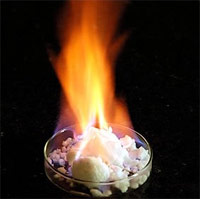Fifty-five million years ago the world's climate was catastrophically changed when volcanoes melted natural gas frozen in the seabed. Now Japan plans to drill for the same icy crystals to end its reliance on imported energy.
Billions of tons of methane hydrate, frozen chunks of chemical-laced water buried in sediment some 3,000 feet under the Pacific Ocean floor, may help Japan win energy independence from the Middle East and Indonesia. Japanese engineers have found enough ``flammable ice'' to meet its gas use demands for 14 years. The trick is extracting it without damaging the environment.
Japan is joining the U.S. and Canada in test drilling for methane even as scientists express concerns about any uncontrolled release of the frozen chemical. Some researchers blame the greenhouse gas for triggering a global firestorm that helped wipe out the dinosaurs.
``Methane hydrate was a key cause of the global warming that led to one of the largest extinctions in the earth's history,'' says Ryo Matsumoto, a University of Tokyo scientist who has studied frozen gas since 1987. ``By making the best use of our wisdom, knowledge and technology, we should be able to utilize this wisely as a new energy.''
If successful, the gas drilling project could help Japan reduce a liquefied natural gas import bill that last year was 2.66 trillion yen ($23.3 billion). The country's LNG imports totaled 62.2 million metric tons, equivalent to 3.03 trillion cubic feet, according to the Ministry of Finance's trade report.
``We are closely watching the government's methane hydrate project, expecting some day to start receiving gas via pipelines from the continental shelf,'' says Toshiharu Okui, deputy general manager of gas resources at Tokyo Gas Co., the country's largest distributor of natural gas.
500 Meters Thick
Trapped within sheets of ice up to 500 meters (1,640 feet) thick is an estimated 40 trillion cubic feet of crystalline methane encased in an ocean trench called the Nankai Trough, 30 miles (50 kilometers) off the coast of the main Honshu Island.
``Reserves aren't as much as Saudi Arabia's or Russia's, but they will contribute to us cutting our heavy dependence on imports,'' says Yoshifumi Hashiba, deputy director of the trade ministry's petroleum and natural gas division.
Exploiting the Nankai Trough depends on developing technical know-how through a test project in Canada's frozen north, says Kenichi Yokoi, team leader of the methane hydrate research project at state-controlled Japan Oil, Gas and Metals National Corp., known as Jogmec.
``Test production in Canada's permafrost is the key to provide clues and determine how methane hydrate can be tapped for mass production,'' says Yokoi. ``Conventional drilling technologies won't be applied for methane hydrate exploitation.''
Test Drilling Results
The most efficient method has proved ``depressurizing,'' which requires deep bore holes being drilled into the ice sheets. Pressure within the chamber is reduced by a pump, causing gaseous methane to separate from the water and ascend to the well head.
A first round of drilling was completed in April by Jogmec and the Canadian government and a second set of tests are scheduled for early 2008. The two governments won't disclose results due to a confidentiality agreement, Jogmec's Yokoi says.
Commercial exploitation of methane hydrate is economically viable when oil trades above $54 a barrel, Japan's government estimated two years ago. The trade ministry is targeting 2016 to start production, corresponding with the scheduled completion of the 16-year government-led test project.
While governments are attracted to an abundant clean fuel, drilling risks disturbing the seabed and triggering an uncontrolled release, says Matsumoto of the University of Tokyo.
``A mass release of methane into the sea and the atmosphere is a risk for global warming,'' he says. ``Massive landslides at the ocean floor must be avoided when drilling at the Nankai Trough.''
Undersea Landslides
Undersea landsides triggered by volcanoes that occurred more than fifty million years ago resulted in the release of methane hydrate, contributing to global warming that lasted tens of thousands of years, says Matsumoto.
Japan's government is promising rigorous environmental controls with gas-leakage detectors and monitoring systems in place before the scheduled test drilling in as early as 2009.
``Energy security and environment protection cannot be apart from each other,'' says the trade ministry's Hashiba. ``We need a comprehensive assessment.''
Among other concerns are that the separation of sea water and colder fresh water will cause ocean temperatures in the Nankai Trough to fall, says Hashiba. The area is a habitat for red sea bream, a fish delicacy.
Fishing Bank Threat
``We're worried that drilling work might harm our fishing banks out there and eventually reduce our catches of red sea bream,'' says Hironori Watanabe at the Katsuura City fishery association.
A bigger worry is evidence that the undersea ice may already be melting. In September, Matsumoto joined a research party in the Sea of Japan to follow up on a 2006 discovery by his university colleagues of methane gas bubbles rising from the ocean floor.
``It's ironically recurring,'' Matsumoto says. ``Extinction of living organisms has repeatedly taken place in the earth's history, and dead bodies were accumulated in soil and under the sea bed, and turned to oil and natural gas.''


